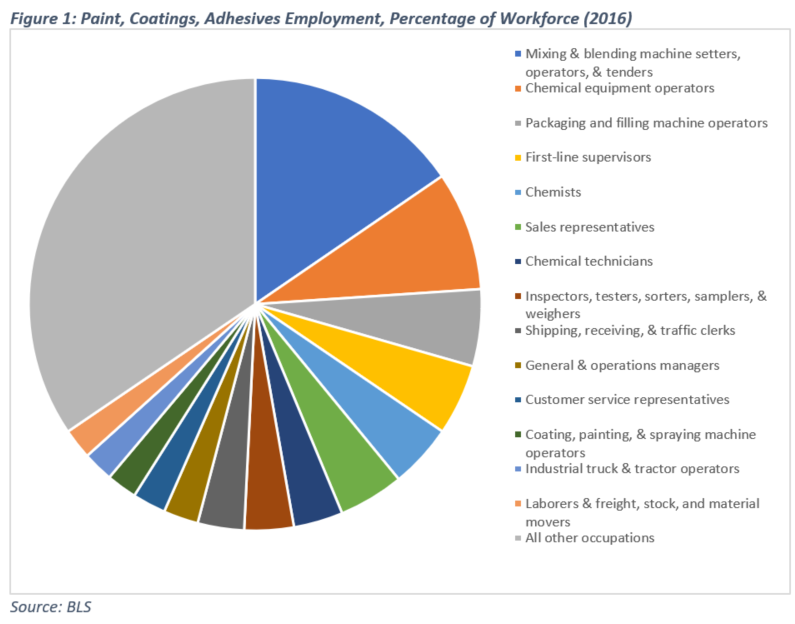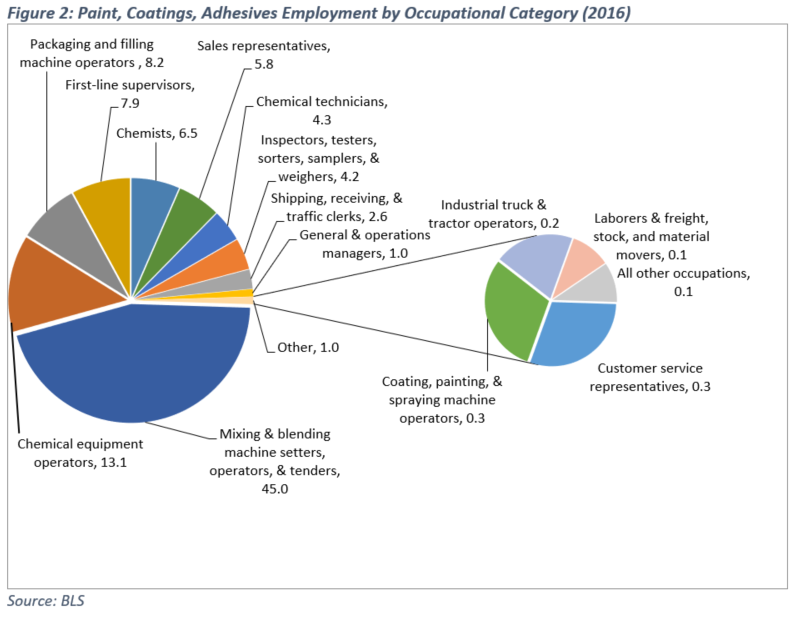There has been extensive coverage of the declining unemployment rates and the increased size of the U.S. workforce during the current economic expansion. Going forward, the Bureau of Labor Statistics (BLS) anticipates that total U.S. employment will add approximately 11.5 million jobs through 2015, rising to 167.6 million, a rise of 7.4%.
This outlook, of course, is not uniform across all sectors of the economy. While projecting increases in the overall U.S. workforce, BLS is simultaneously forecasting decreased employment in manufacturing in general, including for the paint, coatings, and adhesives industries (PCA).[1] For the PCA sector, BLS is forecasting employment to decline from over 62,000 in 2016 to around 58,500 in 2026, an overall decline of 5.9%. Manufacturing overall is projected to see employment fall from 14.2 million to 12.3 million, a nearly 13% decline.
While BLS is projecting decline in the manufacturing workforce, it is simultaneously projecting that production (output) will increase from $5.3 billion to $6.5 billion, adjusted for inflation.[2] While BLS does not provide output projections for the PCA industries, it seems safe to assume that total output in that sector will rise, particularly as its demand drivers manufacturing and construction, are projected to rise (the construction sector in particular is projected to rise from $1,234 billion in 2016 to $1,614 billion in 2016, a 31% increase in real output).[3]
The BLS data provides significant detail on how PCA breaks down employment by job type. As shown in Figure 1, the largest employment category in the industry is “Mixing and blending machine setters, operators, and tenders,” followed by “Chemical equipment operators and tenders.” Both these occupational categories are projected to decrease in numbers by 2026 — they will increase as a percentage of overall industry employment, as other occupational categories, particularly in the secretarial and clerical jobs, decline.

The largest overall projected decline in any job category will be for “Inspectors, testers, sorters, samplers, and weighers.” Interestingly, Chief Executive Officers are projected to decline 18.8% during this period, which is most likely the outcome of anticipated continued consolidation.

Figure 2 breaks down PCA industry employment in a slightly different way, looking at occupational categories, rather than discrete jobs. Here, production jobs are dominant, accounting for nearly half of all industry employment. The production category is followed by administration, science occupations (think chemists), and management.
Contact ACA’s Allen Irish for more information.
[1] In this program BLS provides industry projections only to the 4-digit NAICS level, thus it has made projections only for NAICS 3255, “Paint, coating, and adhesive manufacturing.”
[2] BLS expresses both years’ production in “chained 2009” dollars, which is one method to adjust for inflation.
[3] BLS bases its labor force projections on a variety of expectations of the future size and composition of the population, as well as on the trends in labor force participation rates of different age, gender, race, and ethnic groups, combined with models of future economic growth, etc. For a detailed overview of the methodology employed in making these projections, go to https://www.bls.gov/emp/documentation/projections-methods.htm.
The post Coatings and Adhesive Industry Employment Projected to Decline in Coming Decade appeared first on American Coatings Association.
from American Coatings Association https://www.paint.org/bls-pca/
via IFTTT

No comments:
Post a Comment